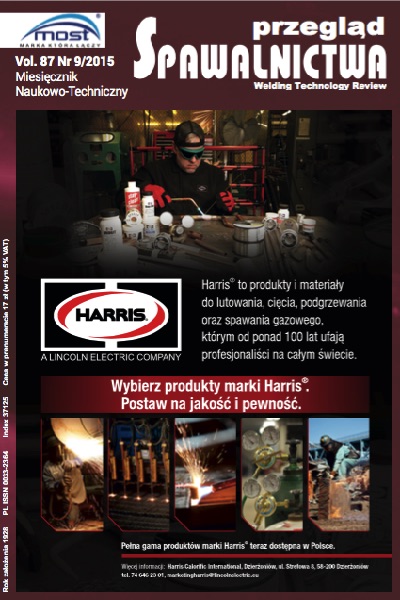Wytwarzanie powłok i modyfikacja powierzchni przy użyciu wiązki elektronów w spawalnictwie
Main Article Content
Abstract
Wiązka elektronów, pomimo szeroko rozpowszechnionych technologii łukowych oraz laserowych, jest nadal powszechnie stosowana w przemyśle: motoryzacyjnym, budowie maszyn, elektronicznym, elektrotechnicznym i lotniczym. Technologia umożliwia wykonywanie wysokiej jakości połączeń z wszystkich spawalnych metali konstrukcyjnych. Jest również stosowana do wytwarzania warstw i powłok poprzez napawanie i modyfikowanie powierzchni. W artykule przybliżono przykłady zastosowania wiązki elektronów uwzględniając szybkie prototypowanie, teksturyzację powierzchni, napawanie przy użyciu drutu oraz proszku, stopowanie. Podano informacje dotyczące możliwych technik jakie mogą być stosowane w trakcie w/w procesów.
Production of coatings and surface modification using electron beam in welding
Abstract
Electron beam, despite widespread arc and laser technologies, is still widely used in industry such as: automotive, mechanical engineering, electronics, electrical and aerospace. The technology allows to produced high quality welded joints from all weldable structural metals. It is also used for the production of films and coatings by deposition and surface modification. In the paper approximated examples of the use of the electron beam given by the rapid prototyping, texturisation surface, cladding with wire and powder as well as alloying. Provides information about the possible techniques that can be used during these processes.
Downloads
Article Details
Creative Commons CC BY 4.0 https://creativecommons.org/licenses/by/4.0/
Welding Technology Review (WTR) articles are published open access under a CC BY licence (Creative Commons Attribution 4.0 International licence). The CC BY licence is the most open licence available and considered the industry 'gold standard' for open access; it is also preferred by many funders. This licence allows readers to copy and redistribute the material in any medium or format, and to alter, transform, or build upon the material, including for commercial use, providing the original author is credited.
References
L.A., Dobrzański, A.D. Dobrzańska-Danikiewicz, Obróbka powierzchni materiałów inżynierskich, 2011, tom 5, Open Access Library.
H. Szymański, K. Friedel, W. Słówko, Urządzenia elektronowiązkowe WNT, Warszawa 1990.
M.St. Węglowski, S. Błacha, S. Dworak, Spawanie wiązką elektronów charakterystyka metody Biuletyn Instytutu Spawalnictwa, vol.58 (3), s. 25-32, 2014.
M.St. Węglowski, S. Błacha, S. Dworak, Spawanie wiązką elektronów urządzenia i wyposażenie Biuletyn Instytutu Spawalnictwa, vol.58(4), s. 46-52, 2014.
Technical Scheets. Electron Beam Welding. Materiały techniczne EWF, 2007.
R. Franke, I. Haase, i inni, Friction and wear behaviour of electron beam surface treated aluminium alloys AlSi10Mg(Cu) and AlSi35 Wear, vol.269, s. 921929, 2010.
P. Adamiec, J. Dziubiński, Wytwarzanie i właściwości warstw wierzchnich elementów maszyn transportowych Wydawnictwo Politechniki Śląskiej, Gliwice, 2005.
S.F. Gnyusov, S. Tarasov, Structural phase states and heat aging of composite electron-beam clad coatings Surface & Coatings Tech- nology, vol.232, s. 775783, 2013.
J. Morimoto, N. Abe, i inni. Formation of a Cr3C2/Ni-Cr alloy layer by an electron beam cladding method and evaluation of the layer properties Vacuum, vol. 62, s. 203-210, 2001.
A. Jung, R. Zenker, Elektronenstrahl-Randschichtbehandlung für die Herstellung verschleißbeständiger Auftragschichten auf nichtrosten- den Stählen Mat.-wiss. u. Werkstofftech, vol.45(6), s. 486-495, 2014.
M. Tomie, N. Abe, i inni, Electron beam cladding of titanium on stainless steel plate Transactions of JWRI, vol.19(1), s. 51-55, 1990.
N.K. Galchenko, K.A. Kolesnikova, i inni, Structure and Properties
of Boride Coatings Synthesized from Thermo-reactive Powders during Electron-beam Surfacing Advanced Materials Research, vol.880, s. 265-271, 2014.
N. Abe, J. Morimoto, i inni, Formation of WC-Co layers by an electron beam cladding method and evaluation of the layer properties Vacuum, vol.59, s. 373-380, 2000.
D.S. Krivezhenko, L.S. Laptev, i inni, Electron-Beam Cladding of Boron Carbide on Low-alloyed Steel at the Air Atmosphere Applied Mechanics and Materials, vol.698, s. 369-373, 2015.
T. Mohandas, D. Banerjee, i inni, Fusion Zone Microstructure and Porosity in Electron Beam Welds of an α+β Titanium Alloy Metallurgical and Materials Transactions A, vol.30A, s. 789-798, 1990.
J. Huang, N. Warnken, Hydrogen Transport and Rationalization of Porosity Formation during Welding of Titanium Alloys Metallurgical and Materials Transactions A, vol. 43A, s. 582-591, 2012.
A.R. Rastkar, B. Shokri, Surface transformation of Ti45Al2Nb 2Mn1B titanium aluminide by electron beam melting Surface and Coatings Technology, vol.204, s. 1817-1822, 2010.
D. Utu, G. Marginean, i inni, Improvement of the wear resistance of titanium alloyed with boron nitride by electron beam irradiation Surface and Coatings Technology, vol. 201, s. 6387-6391, 2007.
M.G. Golkovskia, I.A. Bataev, i inni, Atmospheric electron-beam surface alloying of titanium with tantalum Materials Science and Engineering: A, vol.578, s. 310317, 2013.
J.Ch. Oh, S. Lee, Correlation of microstructure with hardness and fracture properties of (TiC,SiC)/Ti6Al4V surface composites fabricated by high-energy electron-beam irradiation Surface and Coatings Technology, vol.179, s. 340-348, 2004.
E. Yun, K. Lee, i inni, Correlation of microstructure with high temperature hardness of (TiC,TiN)/Ti6Al4V surface composites fabricated by high-energy electron-beam irradiation Surface and Coatings Tech- nology, vol.191, s. 83-89, 2005.
O.G. Lenivtseva, D.V. Lazurenko, i inni, The Structure and Wear Resistance of the Surface Layers Obtained by the Atmospheric Electron Beam Cladding of TiC on Titanium Substrates Applied Mechanics and Materials, vol.682, s. 14-20, 2014.
D. Neagu, Alloying with electron beam of some surfaces on pieces made by non-strengthen materials Nonconventional Technologies Review, 10, s. 31-35, 2010.
Materiały informacyjne firmy Cambridge Vacuum Engeineering, 2013.
C.N. Ribton, High productivity electron beam additive manufacturing International Electron Beam Welding Conference, Aachen, 2012.
